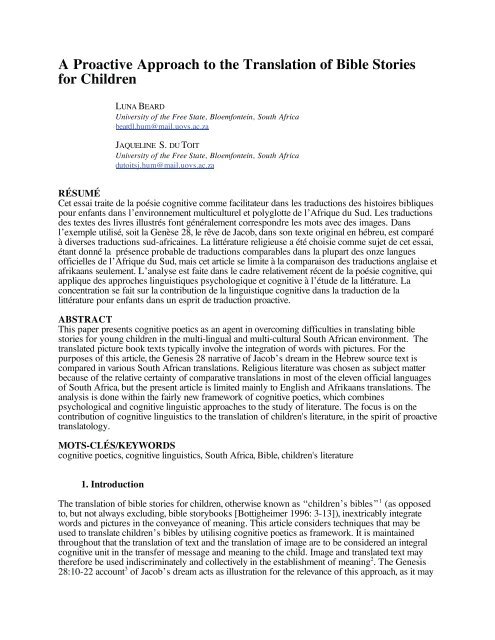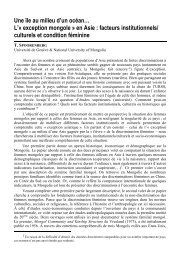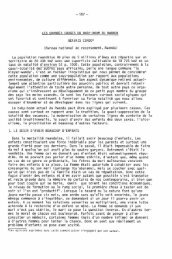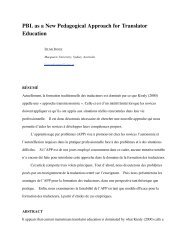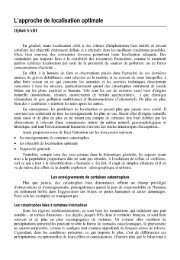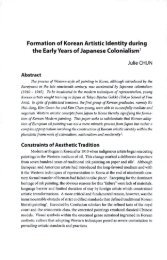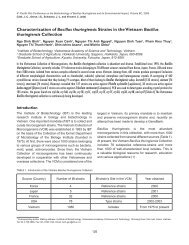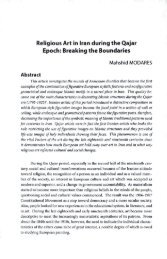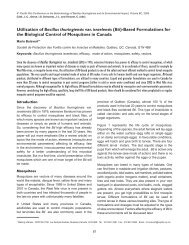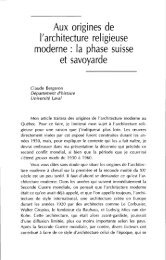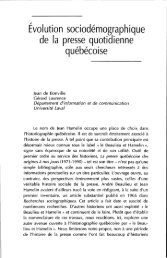A Proactive Approach to the Translation of Bible Stories for Children
A Proactive Approach to the Translation of Bible Stories for Children
A Proactive Approach to the Translation of Bible Stories for Children
Create successful ePaper yourself
Turn your PDF publications into a flip-book with our unique Google optimized e-Paper software.
A <strong>Proactive</strong> <strong>Approach</strong> <strong>to</strong> <strong>the</strong> <strong>Translation</strong> <strong>of</strong> <strong>Bible</strong> S<strong>to</strong>ries<br />
<strong>for</strong> <strong>Children</strong><br />
LUNA BEARD<br />
University <strong>of</strong> <strong>the</strong> Free State, Bloemfontein, South Africa<br />
beardl.hum@mail.uovs.ac.za<br />
JAQUELINE S. DU TOIT<br />
University <strong>of</strong> <strong>the</strong> Free State, Bloemfontein, South Africa<br />
du<strong>to</strong>itsj.hum@mail.uovs.ac.za<br />
RÉSUMÉ<br />
Cet essai traite de la poésie cognitive comme facilitateur dans les traductions des his<strong>to</strong>ires bibliques<br />
pour enfants dans l’environnement multiculturel et polyglotte de l’Afrique du Sud. Les traductions<br />
des textes des livres illustrés font généralement correspondre les mots avec des images. Dans<br />
l’exemple utilisé, soit la Genèse 28, le rêve de Jacob, dans son texte original en hébreu, est comparé<br />
à diverses traductions sud-africaines. La littérature religieuse a été choisie comme sujet de cet essai,<br />
étant donné la présence probable de traductions comparables dans la plupart des onze langues<br />
<strong>of</strong>ficielles de l’Afrique du Sud, mais cet article se limite à la comparaison des traductions anglaise et<br />
afrikaans seulement. L’analyse est faite dans le cadre relativement récent de la poésie cognitive, qui<br />
applique des approches linguistiques psychologique et cognitive à l’étude de la littérature. La<br />
concentration se fait sur la contribution de la linguistique cognitive dans la traduction de la<br />
littérature pour enfants dans un esprit de traduction proactive.<br />
ABSTRACT<br />
This paper presents cognitive poetics as an agent in overcoming difficulties in translating bible<br />
s<strong>to</strong>ries <strong>for</strong> young children in <strong>the</strong> multi-lingual and multi-cultural South African environment. The<br />
translated picture book texts typically involve <strong>the</strong> integration <strong>of</strong> words with pictures. For <strong>the</strong><br />
purposes <strong>of</strong> this article, <strong>the</strong> Genesis 28 narrative <strong>of</strong> Jacob’s dream in <strong>the</strong> Hebrew source text is<br />
compared in various South African translations. Religious literature was chosen as subject matter<br />
because <strong>of</strong> <strong>the</strong> relative certainty <strong>of</strong> comparative translations in most <strong>of</strong> <strong>the</strong> eleven <strong>of</strong>ficial languages<br />
<strong>of</strong> South Africa, but <strong>the</strong> present article is limited mainly <strong>to</strong> English and Afrikaans translations. The<br />
analysis is done within <strong>the</strong> fairly new framework <strong>of</strong> cognitive poetics, which combines<br />
psychological and cognitive linguistic approaches <strong>to</strong> <strong>the</strong> study <strong>of</strong> literature. The focus is on <strong>the</strong><br />
contribution <strong>of</strong> cognitive linguistics <strong>to</strong> <strong>the</strong> translation <strong>of</strong> children's literature, in <strong>the</strong> spirit <strong>of</strong> proactive<br />
transla<strong>to</strong>logy.<br />
MOTS-CLÉS/KEYWORDS<br />
cognitive poetics, cognitive linguistics, South Africa, <strong>Bible</strong>, children's literature<br />
1. Introduction<br />
The translation <strong>of</strong> bible s<strong>to</strong>ries <strong>for</strong> children, o<strong>the</strong>rwise known as “children’s bibles” 1 (as opposed<br />
<strong>to</strong>, but not always excluding, bible s<strong>to</strong>rybooks [Bottigheimer 1996: 3-13]), inextricably integrate<br />
words and pictures in <strong>the</strong> conveyance <strong>of</strong> meaning. This article considers techniques that may be<br />
used <strong>to</strong> translate children’s bibles by utilising cognitive poetics as framework. It is maintained<br />
throughout that <strong>the</strong> translation <strong>of</strong> text and <strong>the</strong> translation <strong>of</strong> image are <strong>to</strong> be considered an integral<br />
cognitive unit in <strong>the</strong> transfer <strong>of</strong> message and meaning <strong>to</strong> <strong>the</strong> child. Image and translated text may<br />
<strong>the</strong>re<strong>for</strong>e be used indiscriminately and collectively in <strong>the</strong> establishment <strong>of</strong> meaning 2 . The Genesis<br />
28:10-22 account 3 <strong>of</strong> Jacob’s dream acts as illustration <strong>for</strong> <strong>the</strong> relevance <strong>of</strong> this approach, as it may
e applied specifically <strong>to</strong> a South African context 4 . Religious literature was chosen as subject matter<br />
because <strong>of</strong> <strong>the</strong> relative certainty <strong>of</strong> comparative translations in most <strong>of</strong> <strong>the</strong> eleven <strong>of</strong>ficial languages<br />
<strong>of</strong> South Africa. And also because <strong>of</strong> <strong>the</strong> curious integration <strong>of</strong> <strong>the</strong> bible, despite its colonial and<br />
missionary past, in<strong>to</strong> <strong>the</strong> current perception <strong>of</strong> African indigenous knowledge 5 , a unique and<br />
interesting twist in <strong>the</strong> domestication <strong>of</strong> bible translation in Africa 6 .<br />
The Constitution <strong>of</strong> <strong>the</strong> Republic <strong>of</strong> South Africa (1996) recognises eleven <strong>of</strong>ficial languages<br />
and grants special privileges <strong>to</strong> languages used <strong>for</strong> religious purposes 7 . Despite <strong>the</strong> constitutionally<br />
recognised status <strong>of</strong> all eleven <strong>of</strong>ficial languages, <strong>the</strong> position <strong>of</strong> at least nine (with <strong>the</strong> exception <strong>of</strong><br />
English and Afrikaans) is tenuous at best as far as publication in <strong>the</strong>se languages, ei<strong>the</strong>r as medium<br />
<strong>of</strong> translation or <strong>for</strong> original work, are concerned (Fredericks & Mvunelo 2003) 8 .<br />
Afrikaans and English children’s bibles are <strong>the</strong>re<strong>for</strong>e used almost exclusively in this paper <strong>to</strong><br />
illustrate a point that will be extrapolated at a later stage in <strong>the</strong> project <strong>to</strong> <strong>the</strong> (hi<strong>the</strong>r<strong>to</strong>) limited<br />
number <strong>of</strong> o<strong>the</strong>r South African translations <strong>of</strong> children’s bibles. The reason being that Afrikaans is<br />
<strong>the</strong> only <strong>of</strong>ficial South African language, o<strong>the</strong>r than English, that is relatively well represented in<br />
children’s literature at present. Also, where <strong>the</strong> target audience <strong>of</strong> <strong>the</strong> English translation is <strong>of</strong>ten<br />
indeterminate, an Afrikaans translation is <strong>for</strong> obvious reasons tailored <strong>to</strong>wards a very specific South<br />
African context. It is hoped that our work will clearly indicate <strong>the</strong> dire need <strong>for</strong> translations in<strong>to</strong> and<br />
from <strong>the</strong> o<strong>the</strong>r nine <strong>of</strong>ficial languages irrespective <strong>of</strong> <strong>the</strong> subject matter or genre, in order <strong>to</strong> bring all<br />
eleven languages <strong>to</strong> equal status.<br />
2. Cognitive Poetics<br />
In <strong>the</strong> spirit <strong>of</strong> proactive transla<strong>to</strong>logy, this article emphasises Ritta Oittinen’s call (2003: 3) <strong>for</strong><br />
greater emphasis on children’s literature in <strong>the</strong> study <strong>of</strong> translation. It also highlights a proactive<br />
approach <strong>to</strong> <strong>the</strong> study <strong>of</strong> children’s literature: a cognitive poetics framework that we suggest may be<br />
successfully utilised in studying <strong>the</strong> translation <strong>of</strong> children’s literature.<br />
The popular attraction <strong>the</strong> bible holds <strong>for</strong> both <strong>the</strong> religious and non-religious may be<br />
explained <strong>to</strong> some extent by <strong>the</strong> remarkable literary character <strong>of</strong> <strong>the</strong> texts (Nida 2003:81), but also<br />
by its imbeddedness in Western tradition. This ingrained Western interpretative tradition, does<br />
however prove in many respects problematic when translating <strong>the</strong>se texts <strong>for</strong> an African audience,<br />
although <strong>the</strong> underlying oral nature <strong>of</strong> <strong>the</strong> transmission his<strong>to</strong>ry <strong>of</strong> <strong>the</strong> source text, does seem <strong>to</strong><br />
appeal strongly <strong>to</strong> a society where orality still holds definite sway in <strong>the</strong> authoritative transmission<br />
<strong>of</strong> in<strong>for</strong>mation. In this respect <strong>the</strong> target culture is much closer <strong>to</strong> <strong>the</strong> source culture than <strong>the</strong><br />
intervening transmission culture would allow.<br />
<strong>Bible</strong> s<strong>to</strong>ries are both rich in fantasy and myth, while generally carrying <strong>the</strong> added attribute <strong>of</strong><br />
non-fiction <strong>for</strong> <strong>the</strong> religious reader/narra<strong>to</strong>r <strong>of</strong> <strong>the</strong>se texts. These s<strong>to</strong>ries thus embrace <strong>the</strong> traditional<br />
divide between fiction and non-fiction. Fur<strong>the</strong>rmore, <strong>the</strong> s<strong>to</strong>ries are typically interpreted by means<br />
<strong>of</strong> an intermediary, i.e. in this instance, read aloud <strong>to</strong> small children at a specific time, usually just<br />
be<strong>for</strong>e bedtime. As such several developmental and o<strong>the</strong>r concerns contribute <strong>to</strong> <strong>the</strong>ir presentation<br />
and understanding, including <strong>the</strong> oral (pre)his<strong>to</strong>ry (Dollerup 2003: 83-84) <strong>of</strong> <strong>the</strong> source text. A very<br />
accommodating framework is <strong>the</strong>re<strong>for</strong>e needed <strong>to</strong> address <strong>the</strong>se peculiarities and cognitive poetics<br />
provides this: a way <strong>of</strong> thinking about literature, involving <strong>the</strong> application <strong>of</strong> cognitive linguistics<br />
and psychology <strong>to</strong> literary texts. In this it is related <strong>to</strong> literary criticism where <strong>the</strong> focus <strong>of</strong> attention<br />
oscillates between ‘author-text-reader’ (S<strong>to</strong>ckwell 2002: 5) with different approaches placing more<br />
or less emphasis on each <strong>of</strong> <strong>the</strong> three nodes. S<strong>to</strong>ckwell (2002: 5) points out that cognitive poetics<br />
can <strong>the</strong>re<strong>for</strong>e be successfully superimposed on<strong>to</strong> this scheme, in <strong>the</strong> sense that it is not restricted <strong>to</strong><br />
one or <strong>the</strong> o<strong>the</strong>r. Concerned with literary reading, and with both a psychological and linguistic<br />
dimension, cognitive poetics <strong>of</strong>fers a means <strong>of</strong> accommodating interpretation whe<strong>the</strong>r it is an<br />
authorly version <strong>of</strong> <strong>the</strong> world or a readerly account, and thus allows <strong>the</strong> possibility <strong>of</strong> devising how<br />
<strong>the</strong>se interpretations are made manifest in textuality (S<strong>to</strong>ckwell 2002:5).<br />
The foundations <strong>of</strong> cognitive poetics are most directly <strong>to</strong> be found in cognitive linguistics and<br />
cognitive psychology, both in turn <strong>for</strong>ming a large part <strong>of</strong> cognitive science. It is, <strong>the</strong>re<strong>for</strong>e not<br />
surprising that context, cognition, emotion and felt experience are emphasized in cognitive poetics
(S<strong>to</strong>ckwell 2002:175). Of <strong>the</strong>se, cognition deserves fur<strong>the</strong>r attention in <strong>the</strong> context <strong>of</strong> this<br />
discussion.<br />
Cognition, in this context, refers <strong>to</strong> how <strong>the</strong> small child acquires in<strong>for</strong>mation about <strong>the</strong> world,<br />
how she represents and trans<strong>for</strong>ms such in<strong>for</strong>mation as knowledge, and how she s<strong>to</strong>res, retrieves<br />
and uses that knowledge <strong>to</strong> direct her behaviour. It may <strong>the</strong>re<strong>for</strong>e be defined as <strong>the</strong> processes and<br />
products <strong>of</strong> our minds. Examples <strong>of</strong> cognitive processes are paying attention, perceiving,<br />
remembering, thinking, reasoning, planning, solving problems, imagining, inferring, conceptualising,<br />
classifying, associating, relating, symbolising, dreaming, and fantasizing. The products <strong>of</strong> our mind<br />
can take on many <strong>for</strong>ms such as writing a book, solving a ma<strong>the</strong>matical problem, creating a painting<br />
or inventing something. Cognitive development is <strong>the</strong> unfolding and also <strong>the</strong> refinement <strong>of</strong> <strong>the</strong>se<br />
cognitive processes and products (Louw, Van Ede & Louw 1998:10). Based on research in<br />
neurology and cognitive psychology, cognitive linguists assume <strong>the</strong>re<strong>for</strong>e that <strong>the</strong>re is a continuum<br />
between language and cognition (especially body-based cognition, but also cognition acquired on<br />
<strong>the</strong> basis <strong>of</strong> social and cultural experience) (Barcelona 2000:2). It is particularly this interplay<br />
between body-based cognition and cognition acquired on <strong>the</strong> basis <strong>of</strong> social and cultural experience<br />
that we endeavour <strong>to</strong> explore in <strong>the</strong> translations <strong>of</strong> bible s<strong>to</strong>ries <strong>for</strong> children.<br />
As <strong>the</strong> <strong>for</strong>mation <strong>of</strong> religious awareness and <strong>the</strong> inculcation <strong>of</strong> religious belief in early<br />
childhood are important in this context, <strong>the</strong> cognitive processes herein involved are also considered.<br />
Over <strong>the</strong> past few decades several new <strong>the</strong>ories about <strong>the</strong> <strong>for</strong>mation <strong>of</strong> religious awareness in<br />
children have been postulated (see, <strong>for</strong> example, Hanekom 2000:26-29). In keeping with our<br />
cognitive poetics approach, this includes <strong>the</strong> incorporation <strong>of</strong> psychology, sociology, anthropology<br />
and o<strong>the</strong>r disciplines in <strong>the</strong> understanding <strong>of</strong> religious belief and belief systems. A holistic<br />
approach that accounts <strong>for</strong> all <strong>the</strong> human senses, as well as cognitive, conative and emotive aspects,<br />
and also complements passive learning processes with activities. The result has been that <strong>the</strong><br />
exclusive consideration <strong>of</strong> verbal communication in <strong>the</strong> transfer <strong>of</strong> religious knowledge <strong>to</strong> children<br />
is no longer tenable. A viewpoint that takes practical application a step fur<strong>the</strong>r emphasizes <strong>the</strong><br />
stimulation <strong>of</strong> <strong>the</strong> imagination in <strong>the</strong> conceptualisation <strong>of</strong> issues <strong>of</strong> religion. Finally, as far as <strong>the</strong><br />
religious potential <strong>of</strong> <strong>the</strong> child is concerned, it is now believed that children can experience religious<br />
belief at a very early age and be<strong>for</strong>e cognitive development is concluded.<br />
Cognitive poetics <strong>the</strong>re<strong>for</strong>e <strong>of</strong>fers a means <strong>of</strong> understanding issues <strong>of</strong> literary value, status<br />
and meaning, as <strong>the</strong>y relate <strong>to</strong> text and context, circumstances and uses, knowledge and beliefs as<br />
S<strong>to</strong>ckwell (2002:4) has indicated.<br />
3. Methodology and Aims<br />
The nature <strong>of</strong> our analysis is such that we incorporate major features from cognitive linguistics in<strong>to</strong><br />
our study <strong>of</strong> children’s bibles. The cognitive linguistic concepts are related <strong>to</strong> <strong>the</strong> literary context in<br />
order <strong>to</strong> produce a cognitive poetic emphasis. Our aim is <strong>to</strong> blend key issues <strong>of</strong> literary reading<br />
(such as <strong>to</strong>ne, character, narrative, plot and genre) with <strong>the</strong> cognitive model that best incorporates <strong>the</strong><br />
feature. To illustrate this, <strong>the</strong> s<strong>to</strong>ry <strong>of</strong> Jacob’s dream (Genesis 28:10-22), is used, and, in particular,<br />
matters related <strong>to</strong> vertical and horizontal space.<br />
4. The S<strong>to</strong>ry <strong>of</strong> Jacob’s Dream<br />
Jacob, grandson <strong>of</strong> <strong>the</strong> patriarch, Abraham, fleeing from his bro<strong>the</strong>r Esau, went <strong>to</strong> sleep at sunset<br />
and <strong>to</strong>ok a s<strong>to</strong>ne as pillow. During <strong>the</strong> night, he dreams <strong>of</strong> a ladder/staircase stretching from <strong>the</strong><br />
earth <strong>to</strong> heaven with angels moving up and down on it. God appears over or on Jacob during <strong>the</strong><br />
dream and confirms his relationship with <strong>the</strong> Jacob. Whereupon Jacob wakes up afraid and realizes<br />
that not only is <strong>the</strong> place where he slept sacred (a “house <strong>of</strong> God ”), but it is a “gate <strong>of</strong> heaven”.<br />
4.1 Dreams and Imagination<br />
Imagination is at <strong>the</strong> core <strong>of</strong> cognitive poetics. One <strong>of</strong> <strong>the</strong> challenges <strong>of</strong> this approach is <strong>the</strong>re<strong>for</strong>e <strong>to</strong><br />
be able <strong>to</strong> explore its workings and understand its mysterious processes (S<strong>to</strong>ckwell 2002: 173).
Imagination, or more technically, <strong>the</strong> ability <strong>to</strong> project concepts on<strong>to</strong> o<strong>the</strong>r concepts, is a major,<br />
albeit general cognitive ability. It is <strong>the</strong>re<strong>for</strong>e no surprise that cognitive scientists are so interested in<br />
imaginative devices such as metaphor (Lak<strong>of</strong>f & Johnson 1999).<br />
4.2 Cognitive Linguistic Tools<br />
In our approach certain cognitive linguistic <strong>to</strong>ols proved particularly helpful in exploring<br />
imagination. Research in cognitive linguistics and more specifically, in cognitive grammar, focuses<br />
on two things in particular: space and time. Space is highly structured within this framework.<br />
Height, verticality, orientation, direction <strong>of</strong> movement, prepositions, deictic elements and<br />
demonstratives become some <strong>of</strong> <strong>the</strong> significant issues addressed within this <strong>the</strong>oretical framework.<br />
For our project, <strong>the</strong>se aspects need <strong>to</strong> be noted in <strong>the</strong> Hebrew source text, in translated texts and in<br />
pic<strong>to</strong>rial representations/translations.<br />
For <strong>the</strong> purposes <strong>of</strong> this study it should also be kept in mind that within cognitive linguistics<br />
all linguistic expressions are <strong>to</strong> a certain extent context-dependent. These cognitive entities, or<br />
domains, may be mental experiences, representational spaces, concepts, or conceptual complexes.<br />
Our sensory capacities provide a variety <strong>of</strong> basic domains: <strong>the</strong> visual system defines <strong>the</strong> potential<br />
<strong>for</strong> two- and three-dimensional visual sensations, co-ordinated with a multidimensional colour<br />
domain. The visual and spatial domains cannot be fully assimilated (even ignoring colour), despite<br />
<strong>the</strong>ir close association, since a blind person is also perfectly capable <strong>of</strong> grasping spatial relations<br />
(Langacker 1987: 147).<br />
To <strong>the</strong> extent that ordering and distance can be specified in a coherent, systematic way <strong>for</strong><br />
certain concepts in a domain, we can describe this domain in terms <strong>of</strong> one or more dimensions.<br />
Time, pitch and temperature exemplify one-dimensional basic domains, since a single, consistent<br />
ordering can be determined <strong>for</strong> <strong>the</strong> entities that occupy <strong>the</strong>m. We are capable <strong>of</strong> dealing with space<br />
in ei<strong>the</strong>r two or three-dimensional terms. Psychophysical research has shown that <strong>the</strong> colour<br />
domain is resolvable in<strong>to</strong> <strong>the</strong> three dimensions <strong>of</strong> brightness, hue and saturation. Dimensionality is<br />
equally important <strong>for</strong> abstract domains. Several dimensions figure, <strong>for</strong> instance, in <strong>the</strong> conception <strong>of</strong><br />
a network <strong>of</strong> kinship relations: one is <strong>the</strong> “vertical” dimension <strong>of</strong> ascending/descending<br />
generations; ano<strong>the</strong>r is <strong>the</strong> “horizontal” dimension <strong>of</strong> lateral relationships; in addition, each node in<br />
a kinship network is potentially specified <strong>for</strong> gender and o<strong>the</strong>r properties (Langacker 1987:149).<br />
This will all feature in <strong>the</strong> discussion <strong>of</strong> <strong>the</strong> space imagery employed in Genesis 28.<br />
4.3 Imagery<br />
“Beloved by children and painters, extravagantly allegorised throughout <strong>the</strong> his<strong>to</strong>ry <strong>of</strong> biblical<br />
interpretation … and an inspiration <strong>to</strong> hymn writers, <strong>the</strong> evocative image <strong>of</strong> Jacob’s ladder is<br />
mentioned only once in <strong>the</strong> <strong>Bible</strong>,” (Ryken, Wilhoit & Longman 1998: 433).<br />
The image <strong>of</strong> Jacob’s ladder, or stairwell (Hebrew: sull!m) 9 , has been interpreted<br />
innumerably in visionary and mystical ways (Ryken, Wilhoit & Longman 1998: 433). In <strong>the</strong> dream,<br />
earthly reality opened up in<strong>to</strong> a vision <strong>of</strong> God and heaven. Jacob’s stairwell <strong>the</strong>re<strong>for</strong>e becomes an<br />
image <strong>of</strong> <strong>the</strong> holy or numinous, as <strong>the</strong> narrative hints when it tells us that Jacob, “[…] was afraid<br />
(Hebrew: wayîr!’), and said, ‘How awesome is this place! This is none o<strong>the</strong>r than <strong>the</strong> house <strong>of</strong><br />
God, and this is <strong>the</strong> gate <strong>of</strong> heaven’ ” (Gen 28:17 RSV).<br />
The imagery <strong>of</strong> ascent names <strong>the</strong> movement from a lower <strong>to</strong> a higher place, and it accordingly<br />
partakes <strong>of</strong> <strong>the</strong> generally positive associations <strong>of</strong> being high. Some <strong>of</strong> <strong>the</strong> imagery <strong>of</strong> ascent takes<br />
its place within <strong>the</strong> two-tiered picture <strong>of</strong> <strong>the</strong> universe that <strong>the</strong> bible assumes (Ryken, Wilhoit &<br />
Longman 1998: 49). Heaven is above <strong>the</strong> earth, and creatures or people (<strong>for</strong> example, Enoch, Elijah)<br />
who move from earth <strong>to</strong> heaven do so by ascending. Thus angels descend from and ascend <strong>to</strong><br />
heaven in Genesis 28:12. This agrees with <strong>the</strong> general ancient Near Eastern context <strong>of</strong> <strong>the</strong> source<br />
text, where <strong>the</strong> cultic places <strong>for</strong> sacrificial purposes as a rule were also referred <strong>to</strong> as “high places”<br />
(Hebrew: b!môt). Pilgrimages <strong>to</strong> Jerusalem, that most sacred <strong>of</strong> cities in <strong>the</strong> source text, follow <strong>the</strong><br />
same directional orientation <strong>of</strong> “going up” (Hebrew: ‘!lâ) and <strong>for</strong> <strong>the</strong> geographically flat terrain <strong>of</strong><br />
<strong>the</strong> Mesopotamian hinterland, <strong>the</strong> Babylonians and Assyrians compensated with <strong>the</strong> erection <strong>of</strong>
artificial high places, <strong>the</strong> ziggurats, <strong>of</strong> which <strong>the</strong> most famous is <strong>the</strong> so-called Tower <strong>of</strong> Babel,<br />
polemically alluded <strong>to</strong> in Genesis 11:1-9 <strong>to</strong> which <strong>the</strong> Genesis 28 narrative bears strong parallels 10 .<br />
In sharp contrast, <strong>the</strong> imagery <strong>of</strong> physical descent, <strong>of</strong> going down, is part <strong>of</strong> <strong>the</strong> directional<br />
imagery <strong>of</strong> <strong>the</strong> bible that is <strong>of</strong>ten close <strong>to</strong> <strong>the</strong> surface as we read. The human imagination has,<br />
however, nearly always used directional imagery <strong>for</strong> symbolic meaning as well. A leading cluster <strong>of</strong><br />
biblical images (Ryken, Wilhoit & Longman 1998: 204) is based on <strong>the</strong> general premise <strong>of</strong> <strong>the</strong><br />
human imagination that up is good and down bad (as is also captured by conceptual metaphors in<br />
cognitive linguistics); namely, that high is desirable and low undesirable; that <strong>to</strong> ascend is positive<br />
and <strong>to</strong> descend negative.<br />
One <strong>of</strong> <strong>the</strong> images <strong>of</strong> descent in <strong>the</strong> bible is more positive, though, based on <strong>the</strong> premise <strong>of</strong> a<br />
two-tiered universe in which God and his heavenly abode are above <strong>the</strong> earth: God’s coming down<br />
<strong>to</strong> earth becomes an image <strong>of</strong> <strong>the</strong> intervention <strong>of</strong> a transcendent deity in <strong>the</strong> activities <strong>of</strong> humankind,<br />
vis-à-vis <strong>the</strong> apathy <strong>to</strong>wards <strong>the</strong> fate <strong>of</strong> humankind displayed by <strong>the</strong> gods in o<strong>the</strong>r ancient Near<br />
Eastern religious contexts 11 . Descent accompanies Yahweh’s appearance <strong>to</strong> his people, whe<strong>the</strong>r<br />
directly and/or through <strong>the</strong> agency <strong>of</strong> angels (Hebrew: mal’!kîm, meaning, literally,<br />
“messengers”), but also signifies <strong>the</strong> deity’s active interest in humankind. The dream is <strong>the</strong>re<strong>for</strong>e a<br />
very com<strong>for</strong>ting event, yet it is filled with awe, wonder, and “fear”, according <strong>to</strong> <strong>the</strong> source text. In<br />
this it responds well <strong>to</strong> what Frey & Griffith (1987: ix) describe as <strong>the</strong> typical inconsistency <strong>to</strong> be<br />
found in children’s literature: “We see in children’s books much <strong>of</strong> <strong>the</strong> grotesqueness,<br />
metamorphosis, seeming illogic, and teasingly veiled insights that we associate with dreams. To us,<br />
great writing <strong>for</strong> children <strong>of</strong>ten tends <strong>to</strong> hover over <strong>the</strong> glowing border between good dream and<br />
nightmare, between cosy domesticity and sharp family struggle, between edenic nostalgia and<br />
sobering maturity.”<br />
4.4 Psychological-Developmental Concerns<br />
The s<strong>to</strong>ry <strong>of</strong> Jacob’s dream set at <strong>the</strong> beginning <strong>of</strong> <strong>the</strong> narrative describing Jacob’s journey from<br />
home (<strong>of</strong>ten headlined in children’s bibles by <strong>the</strong> heading, “Running away from home”), provides<br />
a learning opportunity <strong>for</strong> a young child in a religious environment. It provides an adult narra<strong>to</strong>r <strong>the</strong><br />
opportunity <strong>to</strong> explain <strong>the</strong> cultural life world <strong>of</strong> <strong>the</strong> source text because <strong>of</strong> <strong>the</strong> richness <strong>of</strong> <strong>the</strong><br />
pic<strong>to</strong>rial imagery, <strong>for</strong> example, aspects such as dreams and parental blessings in <strong>the</strong> ancient Near<br />
Eastern world, <strong>the</strong> nature and role <strong>of</strong> angels and places <strong>of</strong> worship, as well as <strong>the</strong> deity’s proximity<br />
and protection.<br />
An approach that takes context so seriously, though, has <strong>to</strong> take cognisance <strong>of</strong> <strong>the</strong> many<br />
fac<strong>to</strong>rs that needs <strong>to</strong> be considered as <strong>to</strong> <strong>the</strong> inclusion, graphic presentation and translation <strong>of</strong> this<br />
s<strong>to</strong>ry in children’s bibles.<br />
As regards children’s notion <strong>of</strong> movement along vertical structures, children are usually able<br />
<strong>to</strong> climb stairs as <strong>of</strong> thirteen months (Louw, Van Ede & Louw 1998: 168). <strong>Children</strong> are also aware<br />
<strong>of</strong> social hierarchies from a very young age (Louw, Gerdes & Meyer 1985: 235). This is important<br />
as <strong>the</strong> Genesis 28:10-22 account has been imbedded in <strong>the</strong> Jacob Cycle, and directly preceded by<br />
<strong>the</strong> genealogical sequence <strong>of</strong> verses 6-9. The Jacob Cycle explains <strong>the</strong> position <strong>of</strong> Jacob in <strong>the</strong><br />
tradition as patriarch and Genesis 28:10-22 is pivotal in this account as it acts as confirmation <strong>of</strong><br />
Jacob’s position in <strong>the</strong> patriarchal hierarchy, as <strong>the</strong> place where <strong>the</strong> dream is said <strong>to</strong> occur, Be<strong>the</strong>l, is<br />
associated with Abraham.<br />
The children’s bibles and source material used <strong>for</strong> <strong>the</strong> purposes <strong>of</strong> this study are aimed at<br />
children aged 5–8 years. The period from approximately <strong>the</strong> sixth <strong>to</strong> <strong>the</strong> twelfth year <strong>of</strong> life is<br />
known as middle childhood. Psychologists agree that, although it is a period <strong>of</strong> relative calm in<br />
respect <strong>of</strong> physical development, it is never<strong>the</strong>less an important period in children’s cognitive,<br />
social, emotional, and self-concept development (Louw, Van Ede & Louw 1998: 322), thus gaining<br />
a better understanding <strong>of</strong> <strong>the</strong>ir world.<br />
At this age balance and elegance <strong>of</strong> physical movement also improve considerably (Louw,<br />
Van Ede & Louw 1998: 325). They are extremely physical and run, jump, swim and climb up and<br />
down frames and structures in free play (Blom 2004:125).
In terms <strong>of</strong> reading development, <strong>the</strong> members <strong>of</strong> middle childhood fall in<strong>to</strong> <strong>the</strong> second <strong>of</strong><br />
Retief’s (1990:36) four stages:<br />
0 – 5 yrs: Preschool reader (picture books)<br />
6 – 8 yrs: Beginner reader (picture books)<br />
9 – 11 yrs: Transition away from picture books<br />
12+ yrs: Juvenile literature<br />
There is significant language development during middle childhood. This not only involves<br />
an increased vocabulary and more complex sentence structures, but also <strong>the</strong> improved ability <strong>to</strong><br />
adapt language and style <strong>of</strong> language <strong>to</strong> <strong>the</strong> context in which it is used. For instance, <strong>the</strong> child’s<br />
language while speaking <strong>to</strong> her teacher will differ from <strong>the</strong> language she uses when speaking <strong>to</strong> a<br />
friend. Also, between <strong>the</strong> ages <strong>of</strong> three and four, preschool children begin <strong>to</strong> understand figurative<br />
expressions such as, “<strong>the</strong> clouds look like castles”. By school going age (roughly at <strong>the</strong> beginning<br />
<strong>of</strong> middle childhood), children understand metaphorical language such as, “<strong>the</strong> sun is like a piece<br />
<strong>of</strong> glowing coal” and, “a heart <strong>of</strong> gold” (Mussen, Conger, Kagan & Hus<strong>to</strong>n 1990).<br />
As <strong>for</strong> dreaming, R<strong>of</strong>fwarg, Muzio and Dement (1966) found that neonates spend about half<br />
<strong>of</strong> <strong>the</strong>ir sleeping time in REM (rapid eye movement) sleep, associated with dreaming. And <strong>the</strong><br />
processing <strong>of</strong> dreams has been done during gestalt play <strong>the</strong>rapy with children as young as six years<br />
<strong>of</strong> age (Blom 2004: 165). This <strong>of</strong>ten helps children <strong>to</strong> develop new strategies <strong>for</strong> coping with<br />
emotions such as fear and anger. This type <strong>of</strong> <strong>the</strong>rapy is used <strong>to</strong> great effect <strong>for</strong> children grieving<br />
(losing a loved one <strong>to</strong> AIDS, <strong>for</strong> example) and traumatised children (<strong>for</strong> instance, in cases <strong>of</strong> rape,<br />
abandonment, physical violence, extreme poverty, etc.) in <strong>the</strong> South African context 12 .<br />
Some <strong>of</strong> <strong>the</strong> most important symp<strong>to</strong>ms (Blom 2004:214) that may be experienced by such<br />
children include nightmares, fear <strong>of</strong> strangers, changes in <strong>the</strong>ir eating and sleeping patterns,<br />
extraordinary fear <strong>of</strong> <strong>the</strong> dark, fear <strong>of</strong> separation or <strong>of</strong> being alone 13 . Papalia & Olds (1979: 302)<br />
explain <strong>the</strong> development <strong>of</strong> new fears in <strong>to</strong>ddlers as follows: “They know so much more now, and<br />
one <strong>of</strong> <strong>the</strong> things <strong>the</strong>y know is that <strong>the</strong>re are a lot <strong>of</strong> things <strong>to</strong> be afraid <strong>of</strong>. Then, <strong>to</strong>o, <strong>the</strong>ir<br />
imaginations go wild, and <strong>the</strong>y are worried about being attacked by a lion, being in <strong>the</strong> dark, being<br />
abandoned, or falling from high places.”<br />
4.5 The Text in <strong>the</strong> Hebrew <strong>Bible</strong><br />
Eugene Nida (2003:76) has pointed out that instead <strong>of</strong> simply lecturing about principles <strong>of</strong><br />
correspondence between <strong>the</strong> source text and <strong>the</strong> target text, <strong>the</strong> translation process is far better<br />
served by a scholar conferring with a prospective transla<strong>to</strong>r, by going through <strong>the</strong> text <strong>to</strong>ge<strong>the</strong>r as a<br />
means <strong>of</strong> discovering and anticipating potential problems <strong>for</strong> <strong>the</strong> prospective translation. In fact, he<br />
says, this is one <strong>of</strong> <strong>the</strong> most important procedures, because a problem recognized and accurately<br />
identified, is already half solved. This anticipation <strong>of</strong> difficulties in translating is particularly useful<br />
as a transla<strong>to</strong>r is <strong>the</strong>reby prepared <strong>for</strong> potential hiccups that may arise in <strong>the</strong> text and can prepare<br />
accordingly. As a result <strong>the</strong> translating process usually proceeds more rapidly and with fewer<br />
problems. Nida’s suggestion is easily extrapolated <strong>to</strong> accommodate <strong>the</strong> present authors’ approach<br />
<strong>to</strong> translating children’s bibles: taking cognisance <strong>of</strong> <strong>the</strong> cognitive life world <strong>of</strong> both <strong>the</strong> source and<br />
target cultures, as well as <strong>the</strong> necessary interplay <strong>of</strong> both text and picture in <strong>the</strong> translation activity.<br />
South African children’s bibles are most <strong>of</strong>ten translated from American and British English<br />
translations, with little <strong>to</strong> no cognisance given <strong>to</strong> cultural specificity in <strong>the</strong> South African target<br />
culture. The American or British children’s bible is in turn usually derivative from an “adult”<br />
English translation <strong>of</strong> <strong>the</strong> Hebrew source text. Never<strong>the</strong>less, it was found that, in most instances, <strong>the</strong><br />
English “adult” text pretends <strong>to</strong> <strong>the</strong> position <strong>of</strong> source text, <strong>the</strong>reby ignoring <strong>the</strong> Hebrew/Aramaic<br />
or Greek source text.<br />
As children’s bibles lean heavily on images as necessary partners in <strong>the</strong> conveyance <strong>of</strong><br />
message, we suggest that transla<strong>to</strong>rs <strong>of</strong> children’s bibles pay closer attention <strong>to</strong> <strong>the</strong> source texts,<br />
with <strong>the</strong> assistance <strong>of</strong> transla<strong>to</strong>rs, <strong>for</strong> <strong>the</strong> selection <strong>of</strong> s<strong>to</strong>ries, <strong>the</strong> translation <strong>of</strong> text and <strong>the</strong><br />
translation <strong>of</strong> image. To illustrate our strong emphasis on illustration as part and parcel <strong>of</strong>
translation, we refer <strong>to</strong> three concepts in <strong>the</strong> Genesis 28 account: <strong>the</strong> angels, <strong>the</strong> ladder/stairwell and<br />
<strong>the</strong> position <strong>of</strong> God.<br />
4.5.1 Angels<br />
The prevalence <strong>of</strong> angels in <strong>the</strong> Hebrew (Old Testament) source narrative increases with time and<br />
<strong>the</strong>ir presence and multiplicity in function seems <strong>to</strong> increase accordingly in <strong>the</strong> later apocalyptic<br />
literature. The Genesis 28 account is however a fairly ancient s<strong>to</strong>ry imbedded in<strong>to</strong> more recent<br />
material and angels seem <strong>to</strong> function here purely as background imagery 14 , emphasising <strong>the</strong><br />
extraordinariness <strong>of</strong> <strong>the</strong> vertical interchange between <strong>the</strong> deity (above) and <strong>the</strong> sleeping human<br />
(below). This is however seldom adhered <strong>to</strong> in <strong>the</strong> pic<strong>to</strong>rial and textual representations <strong>of</strong> this s<strong>to</strong>ry,<br />
where much is made <strong>of</strong> <strong>the</strong> ladder/stairwell and its occupants darting up and down. The verticality<br />
<strong>of</strong> <strong>the</strong> interchange tends also <strong>to</strong> be downplayed in presentations such as Van der Watt & Joubert’s<br />
(2002) My eerste boodskap, indicating a horizontal, ra<strong>the</strong>r than <strong>the</strong> source text’s firm up-down,<br />
hierarchical relationship between <strong>the</strong> two participants, with <strong>the</strong> resultant negation <strong>of</strong> <strong>the</strong> cognitive<br />
imagery attached, as discussed previously.<br />
As far as appearance is concerned, angels in <strong>the</strong> earlier biblical material are nondescript<br />
agents <strong>of</strong> <strong>the</strong> deity. In <strong>the</strong> later biblical material, however, <strong>the</strong> keen developing interest in <strong>the</strong><br />
heavenly abode is <strong>of</strong>ten associated with elaborate physical descriptions <strong>of</strong> <strong>the</strong> angels in terms <strong>of</strong><br />
light, fire, shining metals, or precious s<strong>to</strong>nes, (in accordance with, <strong>for</strong> example, <strong>the</strong> book <strong>of</strong> Ezekiel),<br />
and garbed in white linen (according <strong>to</strong> <strong>the</strong> book <strong>of</strong> Daniel) (Newsom 1992: 252).<br />
In depicting <strong>the</strong>se heavenly beings, transla<strong>to</strong>r <strong>of</strong> text and image is <strong>the</strong>re<strong>for</strong>e <strong>of</strong>ten reliant on<br />
<strong>the</strong> post-exilic developing interest in angels in <strong>the</strong> source culture and <strong>the</strong> accompanying strong<br />
blend <strong>of</strong> Assyrian-Babylonian iconographic influences that gave rise <strong>to</strong> it. A possible iconographic<br />
derivative <strong>for</strong> many <strong>of</strong> <strong>the</strong> winged images <strong>of</strong> angels provided in text and illustration is <strong>the</strong> Assyrian<br />
apkallus, primeval (male, adult) “sages” that combined human physicality with <strong>the</strong> addition <strong>of</strong><br />
wings (Green 1995: 1848-1849). Many <strong>of</strong> <strong>the</strong> traditional children’s bibles also depict <strong>the</strong> angels<br />
with wings and illuminated against a bright yellow background. Sometimes <strong>the</strong> accoutrements <strong>of</strong><br />
later tradition such as harps and trumpets are added, <strong>the</strong> figures are androgenous and <strong>of</strong>ten also<br />
tend <strong>to</strong>wards younger, <strong>of</strong>ten childlike, Western features (e.g., Hartman 1995: 22), downplaying <strong>the</strong><br />
sense <strong>of</strong> awe and fear evoked by <strong>the</strong> Hebrew text, in favour <strong>of</strong> a more egalitarian approach between<br />
child-audience and biblical character.<br />
4.5.2 The Ladder/Stairwell<br />
As mentioned already, <strong>the</strong> Hebrew word sull!m (stairwell) occurs only once in <strong>the</strong> biblical text,<br />
resulting in many translation variants both in text and image. The stair-imagery in <strong>the</strong> dream is most<br />
probably a derivative from a geographic circumstance in ancient Mesopotamia, where <strong>the</strong> general<br />
absence <strong>of</strong> high places (<strong>of</strong>ten associated with access <strong>to</strong> <strong>the</strong> gods/heaven) led <strong>to</strong> <strong>the</strong> building <strong>of</strong><br />
<strong>to</strong>wer-like structures (ziggurats), artificial mountains, <strong>for</strong> <strong>the</strong> purpose <strong>of</strong> worship. These ziggurats<br />
are archaeologically well attested throughout <strong>the</strong> floodplains <strong>of</strong> <strong>the</strong> Tigris and <strong>the</strong> Euphrates rivers.<br />
They were multiple tiered <strong>to</strong>wer-like structures that were accessed by enormous ceremonial<br />
staircases, <strong>of</strong> <strong>the</strong>se <strong>the</strong> greatest was <strong>the</strong> ziggurat built <strong>for</strong> Marduk <strong>of</strong> Babylon (<strong>the</strong> legendary Tower<br />
<strong>of</strong> Babel). It was 91,5 m in breadth, length and height (Von Soden 1994: 192). The monumental<br />
staircases <strong>of</strong> <strong>the</strong>se <strong>to</strong>wers are <strong>the</strong> most obvious templates <strong>for</strong> <strong>the</strong> vehicle <strong>of</strong> vertical movement <strong>of</strong> <strong>the</strong><br />
angels in <strong>the</strong> dream.<br />
Some comment has already been made on <strong>the</strong> origins, and translation, <strong>of</strong> <strong>the</strong> vertical motif <strong>of</strong><br />
<strong>the</strong> stairwell on which <strong>the</strong> angels ascend and descend in <strong>the</strong> Genesis 28 account. It is evident that<br />
<strong>the</strong> lack <strong>of</strong> obvious functionality <strong>of</strong> <strong>the</strong> angels (cf. Sarna 1989:198) in <strong>the</strong> account has not escaped<br />
many <strong>of</strong> <strong>the</strong> modern transla<strong>to</strong>rs <strong>of</strong> <strong>the</strong> s<strong>to</strong>ry. In a clear attempt at simplification (<strong>of</strong>ten erroneously<br />
associated with adapting adult source material <strong>for</strong> children), Larsen (1995: 120), <strong>for</strong> example,<br />
completely deleted <strong>the</strong> angel/stairwell imagery from both text and illustration as superfluous. The<br />
passage entitled, “Jacob’s Dream”, <strong>the</strong>re<strong>for</strong>e indicates Jacob as a very small boy, sleeping, with an
empty puff <strong>of</strong> smoke (a la <strong>the</strong> comic strips), above his head. The text echoes <strong>the</strong> “emptiness” left<br />
by <strong>the</strong> absence <strong>of</strong> <strong>the</strong> vertical motif: “When Jacob fell asleep he had a dream. God <strong>to</strong>ld him<br />
everything was going <strong>to</strong> be alright, …” (Larsen 1995: 120). The audience is left with a sense <strong>of</strong><br />
horizontal continuation in narrative and image, thus depriving <strong>the</strong> reader <strong>of</strong> any imaginary<br />
component, as so eloquently provided by <strong>the</strong> mix <strong>of</strong> myth and fantasy in <strong>the</strong> original account. An<br />
even more explicit negation <strong>of</strong> <strong>the</strong> vertical imagery is found where <strong>the</strong> stairs are indicated, but<br />
running more or less horizontally across <strong>the</strong> picture frame (ONS GROOT PRENTEBYBEL 2000:<br />
n.p.).<br />
4.5.3 The Position <strong>of</strong> <strong>the</strong> Deity<br />
The lack <strong>of</strong> a vertical relationship mentioned in Larsen’s (1995: 120) rendering, also contributes <strong>to</strong><br />
<strong>the</strong> establishment <strong>of</strong> a horizontal, ra<strong>the</strong>r than hierarchical relationship between <strong>the</strong> two parties<br />
involved: God and Jacob. Matters such as Jacob’s “fear ”, after <strong>the</strong> event, <strong>the</strong>re<strong>for</strong>e has <strong>to</strong> be left<br />
untranslated as a result, as it cannot be explained without a sense <strong>of</strong> <strong>the</strong> overpowering awesomeness<br />
<strong>of</strong> a deity coming down from heaven <strong>to</strong> concern himself with <strong>the</strong> affairs <strong>of</strong> humanity. It <strong>the</strong>re<strong>for</strong>e<br />
affects <strong>the</strong> relational depiction <strong>of</strong> <strong>the</strong> space between God and humanity and makes it difficult <strong>for</strong> <strong>the</strong><br />
child <strong>to</strong> understand <strong>the</strong> reason <strong>for</strong> Jacob’s “fear” which Larsen (1995: 89) has <strong>to</strong> convert in<strong>to</strong> a<br />
fear <strong>for</strong> <strong>the</strong> uncertainties that <strong>the</strong> future might hold, ra<strong>the</strong>r than a fear <strong>of</strong> God, as no relational<br />
depiction <strong>of</strong> God vis-à-vis Jacob is given in <strong>the</strong> rendering <strong>of</strong> <strong>the</strong> s<strong>to</strong>ry.<br />
Also, as mentioned be<strong>for</strong>e, in <strong>the</strong> Hebrew source text <strong>the</strong> position <strong>of</strong> God is in no way related<br />
<strong>to</strong> <strong>the</strong> stairwell and <strong>the</strong> activities <strong>of</strong> <strong>the</strong> angels 15 . God is positioned in relation <strong>to</strong> Jacob: “above” or<br />
“on ” or “on <strong>to</strong>p <strong>of</strong>” Jacob (Hebrew: ‘al), <strong>the</strong>reby indicating <strong>the</strong> authority in <strong>the</strong> relationship<br />
between <strong>the</strong> two entities in <strong>the</strong>ir spatial interaction.<br />
4.6 The Text and Pictures in <strong>the</strong> Afrikaans Translated Versions<br />
Van der Watt & Joubert (2002) in yet ano<strong>the</strong>r attempt <strong>to</strong> draw <strong>the</strong> 21 st century child between <strong>the</strong><br />
ages <strong>of</strong> five and eight in<strong>to</strong> <strong>the</strong> s<strong>to</strong>ry depicts a ra<strong>the</strong>r young Jacob peacefully asleep with his dog by<br />
his side. Ryken et al. (1998: 29) points out that <strong>the</strong> bible invokes <strong>the</strong> image <strong>of</strong> <strong>the</strong> dog quite <strong>of</strong>ten,<br />
but rarely in a positive light. The Israelites were familiar with dogs, not as cherished pets, but as<br />
members <strong>of</strong> packs that fed at <strong>the</strong> <strong>to</strong>wn dump and roamed <strong>the</strong> streets at night howling (Psalm 59:6).<br />
The struggle <strong>for</strong> survival at <strong>the</strong> <strong>to</strong>wn dump and a semi-wild existence did not produce friendly dogs.<br />
Dogs seemed <strong>to</strong> know nothing <strong>of</strong> obedience and were dangerous <strong>to</strong> pet (Proverbs 26:17). The fear<br />
<strong>of</strong> being eaten by such dogs was real (Psalm 22:16-17).<br />
What is more problematic about this picture is <strong>the</strong> very rare representation <strong>of</strong> God, in human<br />
guise, on <strong>the</strong> stairwell. The text emphasizes a verse (Genesis 28:13) from <strong>the</strong> 1983-translation <strong>of</strong><br />
<strong>the</strong> Afrikaans bible, which states that God came and s<strong>to</strong>od by Jacob and spoke <strong>to</strong> him. (In <strong>the</strong> Old<br />
Afrikaans Version, as is <strong>the</strong> case <strong>for</strong> <strong>the</strong> King James Version, God is indicated as standing at <strong>the</strong><br />
very <strong>to</strong>p <strong>of</strong> <strong>the</strong> ladder.) Never<strong>the</strong>less, <strong>the</strong> Hebrew source text refers <strong>to</strong> God’s position as “on” or<br />
“on <strong>to</strong>p <strong>of</strong>” Jacob and not necessarily relational in position <strong>to</strong> <strong>the</strong> stairwell. And as has been<br />
pointed out, this is hierarchically significant in terms <strong>of</strong> positioning <strong>of</strong> sacred versus pr<strong>of</strong>ane; but<br />
also in terms <strong>of</strong> authority, God is by virtue <strong>of</strong> position, superior <strong>to</strong> Jacob.<br />
The <strong>to</strong>ne expressed through this picture does not fit <strong>the</strong> awe and respect (“fear”) expressed<br />
in <strong>the</strong> text, as <strong>the</strong> picture is typically overshadowed by conceptual diminutives: God is small and<br />
caricaturised, <strong>the</strong> ladder (not stairs) is short, <strong>the</strong> emotionless Jacob is very young (Jacob was at least<br />
middle aged), with a small dog by his side.<br />
The conceptual diminutives are <strong>of</strong>ten underscored in older Afrikaans children’s bibles by a<br />
natural tendency in Afrikaans <strong>to</strong> fill speech and text aimed at children with <strong>the</strong> diminutive <strong>for</strong>m, <strong>for</strong><br />
example, “little angels” (Afrikaans: engeltjies), and so <strong>for</strong>th (see, De Vries & Geldenhuys n.d.:<br />
36). But in older texts <strong>the</strong> deity is authority figure is upheld by not applying <strong>the</strong> same diminutive<br />
status <strong>to</strong> God in ei<strong>the</strong>r illustration or text. Thereby expressing <strong>the</strong> power relationship between God<br />
and Jacob in terms <strong>of</strong> big (important) vs. small (less important), ra<strong>the</strong>r than as high vs. low, as is <strong>the</strong><br />
case in <strong>the</strong> source text.
5. Discussion and Future Perspectives<br />
So far <strong>the</strong>oretical, linguistic, cognitive poetic and psychological issues have been taken in<strong>to</strong> account.<br />
The next step in <strong>the</strong> research project involves investigating <strong>the</strong> reception <strong>of</strong> <strong>the</strong> various texts on<br />
South African children from <strong>the</strong> designated language communities. This article is <strong>the</strong>re<strong>for</strong>e but an<br />
indica<strong>to</strong>r <strong>of</strong> <strong>the</strong> applicability <strong>of</strong> <strong>the</strong> cognitive poetics approach <strong>to</strong> <strong>the</strong> specific requirements <strong>of</strong> <strong>the</strong><br />
multi-lingual and multi-cultural demands <strong>of</strong> <strong>the</strong> South African circumstances. And, given <strong>the</strong><br />
particular challenges posed by eleven <strong>of</strong>ficial languages, children’s literature in translation has<br />
received very little attention <strong>to</strong> date. In this we would like <strong>to</strong> take <strong>the</strong> approach <strong>of</strong> <strong>the</strong> teacher <strong>of</strong><br />
philosophy at a university in Ecuador (Nida 2003: 82) who, when speaking <strong>of</strong> <strong>the</strong> missionaries,<br />
said, “These fine people have learned our language but never our hearts, because <strong>the</strong>y are so<br />
unaware <strong>of</strong> our literature.”<br />
6. Conclusion<br />
To conclude, as was mentioned earlier, dreams and imagination are central <strong>to</strong> cognitive studies and<br />
<strong>the</strong> s<strong>to</strong>ry <strong>of</strong> Jacob’s ladder acts as foil <strong>to</strong> indicate <strong>the</strong> interpretative possibilities provided by a<br />
cognitive poetics approach <strong>to</strong> children’s bible translation. Text and graphics are inextricably linked<br />
<strong>to</strong> become a cohesive whole and both <strong>the</strong>re<strong>for</strong>e have equal impact on <strong>the</strong> understanding <strong>of</strong> source<br />
and target culture and <strong>the</strong> conveying <strong>of</strong> message.<br />
This approach presents literature and literary analysis as based in general cognitive<br />
experience, including general processes <strong>of</strong> understanding language. It thus also enables <strong>the</strong> analyst<br />
<strong>to</strong> make <strong>the</strong> most <strong>of</strong> connections with o<strong>the</strong>r art <strong>for</strong>ms and media. Hence an ideal frame <strong>of</strong> reference<br />
<strong>for</strong> <strong>the</strong> study <strong>of</strong> picture books <strong>for</strong> children in multi-lingual and multi-cultural settings.<br />
NOTES<br />
1. Great inconsistency exists as <strong>to</strong> whe<strong>the</strong>r children’s bibles are written by “authors” or “transla<strong>to</strong>rs”, or in fact, “retellers”<br />
in <strong>the</strong> way Beckett (2003) uses <strong>the</strong> term <strong>for</strong> <strong>the</strong> transmission <strong>of</strong> a tale such as Little Red Riding Hood. We<br />
are <strong>of</strong> <strong>the</strong> opinion that as children’s bibles are based on a Hebrew, Aramaic or Greek source text, <strong>the</strong> epi<strong>the</strong>t<br />
“transla<strong>to</strong>r” is more appropriate. Certain elements, such as <strong>the</strong> selection <strong>of</strong> s<strong>to</strong>ries included (highly problematic given<br />
<strong>the</strong> canonical nature <strong>of</strong> <strong>the</strong> source text and <strong>the</strong> religious basis <strong>the</strong>re<strong>of</strong>) and <strong>the</strong> assignation <strong>of</strong> subtitles <strong>for</strong> individual<br />
s<strong>to</strong>ries, are inevitably <strong>the</strong> work <strong>of</strong> modern edi<strong>to</strong>rs and authors, not always indicated as such in <strong>the</strong> introduction (where<br />
introductions do exist). Fur<strong>the</strong>rmore, many children’s bibles are dependent on an English or Dutch (<strong>for</strong> South African<br />
audiences) translation <strong>of</strong> <strong>the</strong> source text. This translation, most <strong>of</strong>ten <strong>the</strong> King James Version or <strong>the</strong> Living <strong>Bible</strong>,<br />
Good News <strong>Bible</strong>, and so <strong>for</strong>th, <strong>of</strong>ten acts in <strong>the</strong> guise <strong>of</strong> <strong>the</strong> Hebrew/Aramaic and Greek source text (a pretender<br />
source text, if you will), with no recognition <strong>the</strong>re<strong>of</strong> in <strong>the</strong> children’s bibles. Cognisance also has <strong>to</strong> be taken <strong>of</strong><br />
translational traditions (Dollerup 2003: 91) <strong>the</strong> constraints <strong>of</strong> which are compounded by <strong>the</strong> confessional and<br />
canonical aspects <strong>of</strong> <strong>the</strong> source material and <strong>the</strong> traditional notions <strong>of</strong> <strong>the</strong> adult media<strong>to</strong>r <strong>of</strong> <strong>the</strong> text. Ideology is<br />
<strong>the</strong>re<strong>for</strong>e always present in <strong>the</strong> translation <strong>of</strong> children’s bibles, but <strong>of</strong>ten disguised in a traditional lip service <strong>to</strong> literal<br />
reading <strong>of</strong> religious canon.<br />
2. This may seem self-evident <strong>to</strong> <strong>the</strong> transla<strong>to</strong>rs and scholars pre-occupied with children’s literature, but it is an <strong>of</strong>ten<br />
overlooked aspect <strong>of</strong> <strong>the</strong> religious source material on which children’s bibles are based. As Othmar Keel (1992: 358)<br />
explains: “Although innumeral biblical handbooks are illustrated with pictures from ANE [ancient Near Eastern]<br />
sources, and each year sees <strong>the</strong> appearance <strong>of</strong> yet ano<strong>the</strong>r volume <strong>of</strong> its kind, <strong>the</strong> relationship between biblical texts<br />
and pictures contemporaneous <strong>to</strong> <strong>the</strong>m remains neglected, in that it has never been studied in a systematically<br />
thought-out way, as is normal in <strong>the</strong> o<strong>the</strong>r disciplines <strong>of</strong> biblical research.” Although what Keel refers <strong>to</strong> is an<br />
iconographical tradition in <strong>the</strong> transmission <strong>of</strong> <strong>the</strong> biblical text, this is as true <strong>for</strong> children’s bibles, if not more so,<br />
as <strong>the</strong> genre as such as been sadly neglected until Bottigheimer started working on this in <strong>the</strong> 1980s.<br />
3. The account <strong>for</strong>ms part <strong>of</strong> <strong>the</strong> larger Jacob cycle (Genesis 25:19 <strong>to</strong> 35:29), but scholars have long agreed that this<br />
s<strong>to</strong>ry probably predates much <strong>of</strong> <strong>the</strong> rest <strong>of</strong> <strong>the</strong> cycle and was inserted in<strong>to</strong> it.
4. This article is imbedded in a six-year research project by <strong>the</strong> authors. The project is interdisciplinary in nature and<br />
combines <strong>the</strong> collabora<strong>to</strong>rs’ respective expertise in cognitive linguistics and bible, <strong>to</strong> focus on <strong>Bible</strong> interpretation<br />
in children’s literature. The transfer and interpretation <strong>of</strong> bible (religious) knowledge from diverse institutional<br />
and parental sources <strong>to</strong> children: visual and literary interplay. The project is funded by <strong>the</strong> generous financial<br />
assistance <strong>of</strong> <strong>the</strong> South African National Research Foundation’s Thuthuka Program. Any opinion, findings and<br />
conclusions or recommendations expressed in this material are those <strong>of</strong> <strong>the</strong> authors and <strong>the</strong>re<strong>for</strong>e <strong>the</strong> NRF does not<br />
accept any liability in regard <strong>the</strong>re<strong>to</strong>. The financial assistance <strong>of</strong> <strong>the</strong> University <strong>of</strong> <strong>the</strong> Free State is also<br />
acknowledged.<br />
5. Mogomme Masoga (2004: 141-142) on <strong>the</strong> bible as part <strong>of</strong> indigenous knowledge in South Africa: “[…] <strong>the</strong><br />
biblical text stands in a central position. […] It is used daily in a variety <strong>of</strong> contexts – it is used on trains by<br />
preachers; it is used <strong>to</strong> divine and heal by abathandazeli (spiritual/faith healers); it is used […] and read at many<br />
night vigils, by independent and indigenous church preachers and <strong>the</strong>ir followers, in cold tents and shanty buildings,<br />
[…] characterised by singing, clapping <strong>of</strong> hands and pulsating drumming, dancing in cycles and humming <strong>the</strong> songs<br />
with a strong sense <strong>of</strong> African reper<strong>to</strong>ire.”<br />
6. A non-traditional application <strong>of</strong> <strong>the</strong> term “domestication”, but never<strong>the</strong>less, we would argue, applicable in this<br />
instance.<br />
7. Article 6(1): “The <strong>of</strong>ficial languages <strong>of</strong> <strong>the</strong> Republic are Sepedi, Sesotho, Setswana, siSwati, Tshivenda,<br />
Xitsonga, Afrikaans, English, isiNdebele, isiXhosa and isiZulu.” Article 6(5) continues <strong>to</strong> grant <strong>the</strong> Pan South<br />
African Language Board <strong>the</strong> authority <strong>to</strong> promote <strong>the</strong> development and use <strong>of</strong> Khoi, Nama and San languages, as<br />
well as sign language. It also provides special privilege (“respect”) <strong>for</strong> languages used <strong>for</strong> religious purposes such as<br />
Hebrew.<br />
8. Beard & Du Toit are at present in <strong>the</strong> process <strong>of</strong> conducting a survey on <strong>the</strong> publication status <strong>of</strong> children’s bibles<br />
in all eleven <strong>of</strong>ficial languages.<br />
9. To complicate matters, this is an example <strong>of</strong> a hapax legomenon, one <strong>of</strong> 3000 words that occur only once in <strong>the</strong><br />
biblical Hebrew corpus.<br />
10. The parallels are well reflected in a number <strong>of</strong> visual images in picture books, where <strong>the</strong> direction and <strong>for</strong>m <strong>of</strong><br />
<strong>the</strong> staircase <strong>of</strong>ten strongly recalls what we know from archaeology <strong>of</strong> <strong>the</strong> Babylonian ziggurat referred <strong>to</strong> in Genesis<br />
11 (cf., <strong>for</strong> example, Lingo 2003: 22 and Barnes 2001: 29). This parallel reflects <strong>the</strong> textual references <strong>to</strong> “gate <strong>of</strong><br />
heaven”, and <strong>the</strong> like, that tie <strong>the</strong>se two unusual accounts <strong>to</strong>ge<strong>the</strong>r.<br />
11. The Mesopotamian flood narrative, <strong>the</strong> Epic <strong>of</strong> Atrakhasis (first half <strong>of</strong> <strong>the</strong> second millennium BCE), provides<br />
<strong>the</strong> pro<strong>to</strong>typical example <strong>of</strong> <strong>the</strong> apparent indifference <strong>of</strong> <strong>the</strong> ancient Near Eastern deities vis-à-vis humankind. And <strong>the</strong><br />
flood narrative in Genesis and <strong>the</strong> Hebrew deity’s close involvement with humanity in this narrative is <strong>of</strong>ten<br />
considered <strong>to</strong> be a polemic against <strong>the</strong> ancient Near Eastern understanding <strong>of</strong> <strong>the</strong> divine as disinterested and unaffected<br />
by <strong>the</strong> trials <strong>of</strong> humanity.<br />
12. It is predicted that as many as a quarter <strong>of</strong> South African children may be orphaned by <strong>the</strong> AIDS epidemic in <strong>the</strong><br />
next five years.<br />
13. Larsen’s My bedtime bible (1995) takes cognisance <strong>of</strong> this by reorganising <strong>the</strong> selection <strong>of</strong> bible tales<br />
<strong>the</strong>matically in<strong>to</strong> 365 “devotions <strong>for</strong> children”. On Genesis 28, she asks <strong>the</strong> child audience (Larsen 1995: 89), “What<br />
makes you afraid? How do you think Jacob felt after God talked <strong>to</strong> him?”<br />
14. Nahum Sarna (1989: 198): “It should be noted, though, that in Jacob’s dream, <strong>the</strong> sullam [staircase], whatever it<br />
be, does not function as a channel <strong>of</strong> communication between man and God.” And <strong>the</strong> angels on <strong>the</strong> staircase are not<br />
active participants in <strong>the</strong> interaction between <strong>the</strong> two ei<strong>the</strong>r.<br />
15. By contrast, God is <strong>of</strong>ten depicted, in children’s bibles, in relation <strong>to</strong> <strong>the</strong> stairs/ladder. In children’s bibles God,<br />
or a luminous symbolic image depicting <strong>the</strong> deity, stands at <strong>the</strong> <strong>to</strong>p <strong>of</strong> <strong>the</strong> ladder. In this, <strong>the</strong> children’s bibles follow<br />
<strong>the</strong> text <strong>of</strong> <strong>the</strong> King James Version (KJV), a popular pretender-source text: “And he dreamed, and behold a ladder set<br />
up on <strong>the</strong> earth, and <strong>the</strong> <strong>to</strong>p <strong>of</strong> it reached <strong>to</strong> heaven: and behold <strong>the</strong> angels <strong>of</strong> God ascending and descending on it.<br />
And, behold, <strong>the</strong> Lord s<strong>to</strong>od above it, [...]” (Gen 28:12-13a KJV). This rendering disagrees from <strong>the</strong> Hebrew source<br />
text.<br />
RÉFÉRENCES<br />
BARCELONA, A. (2000): Metaphor and Me<strong>to</strong>nymy at <strong>the</strong> Crossroads: a Cognitive Perspective, Berlin, Mou<strong>to</strong>n de<br />
Gruyter.
BARNES, T. (2001): The Kingfisher <strong>Children</strong>’s bible, London, Kingfisher.<br />
BECKETT, S. L. (2003): “When Modern Little Red Riding Hoods Cross Borders… or Don’t…”, Meta 48-1/2, p. 15-<br />
30.<br />
BLOM, R. (2004): Handbook <strong>of</strong> Gestalt Therapy. Practical Guidelines <strong>for</strong> Child Therapists, Bloemfontein,<br />
Dru<strong>for</strong>ma.<br />
BOTTIGHEIMER, R. B. (1996): The <strong>Bible</strong> <strong>for</strong> <strong>Children</strong>: From <strong>the</strong> Age <strong>of</strong> Gutenberg <strong>to</strong> <strong>the</strong> Present, New Haven,<br />
Yale University.<br />
DE VRIES, A. & A. GELDENHUYS (n.d.): Die mooiste verhale in die wêreld, Cape Town.<br />
DOLLERUP, C. (2003): “<strong>Translation</strong> <strong>for</strong> Reading Aloud”, Meta 48-1/2, p. 81-103.<br />
FREDERICKS, G. H. & Z. MVUNELO (2003): “Publication <strong>of</strong> Books in Indigenous South African Languages and<br />
<strong>the</strong>ir Availability and Use in Public Libraries”, South African Journal <strong>of</strong> Library and In<strong>for</strong>mation Science 69-2, p.<br />
133-139.<br />
FREY, C. & J. GRIFFITH (1987): The Literary Heritage <strong>of</strong> Childhood: an Appraisal <strong>of</strong> <strong>Children</strong>’s Classics in <strong>the</strong><br />
Western Tradition, New York, Greenwood.<br />
GREEN, A. (1995): “Ancient Mesopotamian Religious Iconography”, in SASSON, J. (ed.): Civilizations <strong>of</strong> <strong>the</strong><br />
Ancient Near East III&IV, Peabody, Hendrickson, p. 1837-1856.<br />
HANEKOM, B. (2000): Hoe leer ons kinders glo? Praktiese gids vir ouers, onderwysers en predikante, Welling<strong>to</strong>n,<br />
Lux Verbi BM.<br />
HARTMAN, B. (2001): The Lion S<strong>to</strong>ryteller <strong>Bible</strong>, Ox<strong>for</strong>d, Lion.<br />
KEEL, O. (1992): “Iconography and <strong>the</strong> <strong>Bible</strong>”, in FREEDMAN, D. N. (ed.): The Anchor <strong>Bible</strong> Dictionary 3 H-J,<br />
New York, Doubleday, p. 358-374.<br />
LAKOFF, G. (1987): Women, Fire and Dangerous Things: What Categories Reveal About <strong>the</strong> Mind, Chicago,<br />
University <strong>of</strong> Chicago.<br />
LAKOFF, G. & M. JOHNSON (1980): Metaphors We Live By, Chicago, University <strong>of</strong> Chicago.<br />
LAKOFF, G. & M. JOHNSON (1999): Philosophy in <strong>the</strong> Flesh: <strong>the</strong> Embodied Mind and its Challenge <strong>to</strong> Western<br />
Thought, New York, Basic Books.<br />
LANGACKER, R. W. (1987): Foundations <strong>of</strong> Cognitive Grammar I, Stan<strong>for</strong>d, Stan<strong>for</strong>d University.<br />
LANGACKER, R. W. (1990): Concept, Image and Symbol: <strong>the</strong> Cognitive Basis <strong>of</strong> Grammar, Berlin, Mou<strong>to</strong>n de<br />
Gruyter.<br />
LANGACKER, R. W. (1991): Foundations <strong>of</strong> Cognitive Grammar II, Stan<strong>for</strong>d, Stan<strong>for</strong>d University.<br />
LEE, D. (2004): Cognitive Linguistics: an Introduction, Ox<strong>for</strong>d, Ox<strong>for</strong>d University.<br />
LEVINSON, S. C. (2003): Space in Language and Cognition: Explorations in Cognitive Diversity, Cambridge,<br />
Cambridge University.<br />
LINGO, S. L. (2003): My klein goeienag-bybel, Vereeniging, CUM.<br />
LOUW, D. A., L. C. GERDES & W. F. MEYER (1985): Menslike ontwikkeling, Pre<strong>to</strong>ria, HAUM.<br />
LOUW, D. A., D. M. VAN EDE & A. E. LOUW, A. BOTHA (1998): Human Development, 2 nd ed., Pre<strong>to</strong>ria, Kagiso<br />
Publishers.<br />
MASOGA, M. (2004): “How Indigenous is <strong>the</strong> <strong>Bible</strong>? Challenges Facing 21 st Century South African Biblical<br />
Scholarship”, Journal <strong>for</strong> Semitics 13-2, p. 139-158.<br />
MUSSEN, P. H., J. J. CONGER, J. KAGAN & A. C. HUSTON (1990): Child Development and Personality, 7 th ed,<br />
New York, Harper & Row.<br />
NEWSOM, C. A. (1992): “Angels”, in FREEDMAN, D. N. (ed.): The Anchor <strong>Bible</strong> Dictionary 1 A-C, New York,<br />
Doubleday, p. 248-253.<br />
NIDA, E. A. (2003): Fascinated by Languages, Amsterdam, J. Benjamins.<br />
OITTINEN, R. (2003): « Présentation », Meta 48-1/2, p. 3.<br />
ONS GROOT PRENTEBYBEL (2000): Welling<strong>to</strong>n, Lux Verbi BM.<br />
PAPALIA, D. E. & S. W. OLDS (1979): A Child’s World, 2 nd ed., New York, McGraw-Hill.<br />
RETIEF, H. J. M. (1990): “Uitgee van kinderboeke”, in COETZEE, H. S. & H. J. M. RETIEF (eds.): Kinder- en<br />
jeugboeke: referate gelewer tydens die HAUM-Daan Retief Simposium oor kinder- en jeugboeke, Pre<strong>to</strong>ria,<br />
Universiteit van Pre<strong>to</strong>ria, p. 36-42.<br />
ROFFWANG, H. P., J. N. MUZIO & W. C. DEMENT (1966): “On<strong>to</strong>genetic Development <strong>of</strong> <strong>the</strong> Human Sleep-Dream<br />
Cycle”, Science 152, p. 604-619.<br />
RYKEN, L., J. C. WILHOIT & T. LONGMAN III (eds.) (1998): Dictionary <strong>of</strong> Biblical Imagery, Downer’s Grove,<br />
InterVarsity Press.
SARNA, N. (1989): The JPS Torah Commentary: Genesis, Philadelphia, Jewish Publication Society.<br />
SMITH, C. M. (1982): “Die gebruik van die kinderverhaal as biblioterapeutiese tegniek deur die maatskaplike werker<br />
in gesprekke met kinders”, Maatskaplike Werk/Social Work 19-3, p. 229-236.<br />
STOCKWELL, P. (2002): Cognitive Poetics: an Introduction, New York, Routledge.<br />
STUTTERHEIM, H. & S. KROON (1991): “Die gebruik van biblioterapie in maatskaplike werk”, Maatskaplike Werk/<br />
Social Work 27-2, p. 180-190.<br />
VAN DER MERWE, M. (1996): “Biblio-play”, in SCHOEMAN, J. P. & M. VAN DER MERWE (eds.): Entering <strong>the</strong><br />
Child’s World: a Play Therapy <strong>Approach</strong>, Pre<strong>to</strong>ria, Kagiso, p. 108-116.<br />
VAN DER WATT, J. & S. JOUBERT (2002): My eerste boodskap, Vereeniging, CUM.<br />
VENTER, E. H. (1998): An Assessment Guideline <strong>for</strong> <strong>the</strong> Determination <strong>of</strong> a Child’s Emotional Awareness,<br />
Unpublished MA-dissertation, Pre<strong>to</strong>ria, University <strong>of</strong> Pre<strong>to</strong>ria.<br />
VON SODEN, W. (1994): The Ancient Orient: an Introduction <strong>to</strong> <strong>the</strong> Study <strong>of</strong> <strong>the</strong> Ancient Near East, translation by<br />
D. G. Schley, Grand Rapids, William B. Eerdmans.


